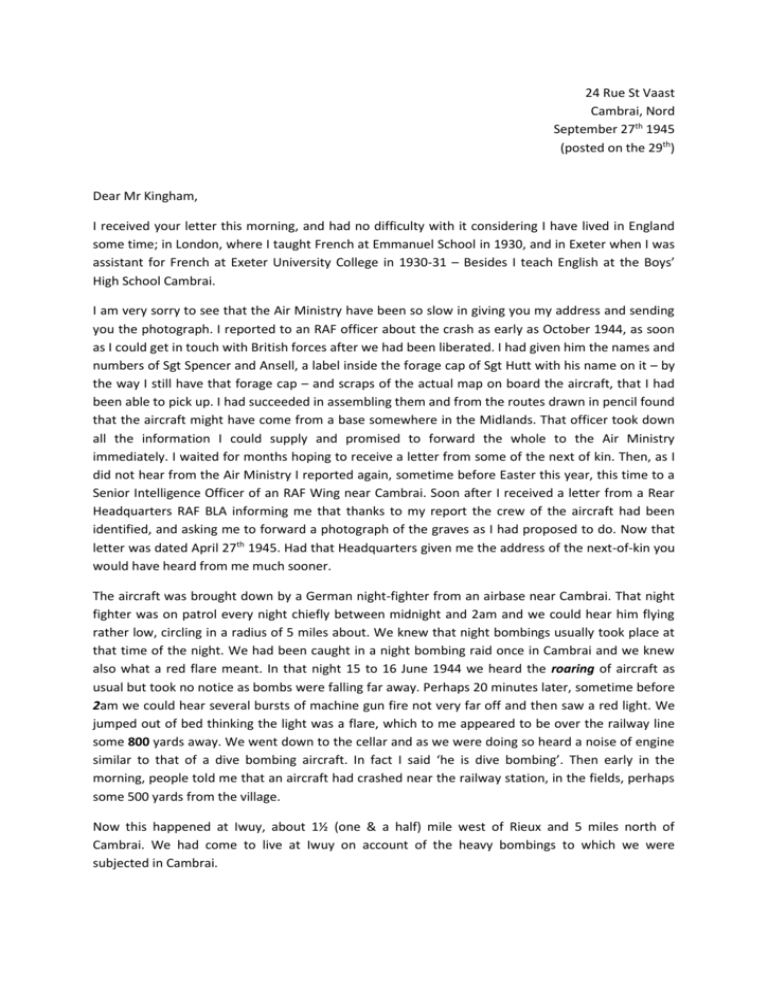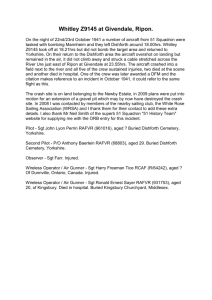Transcribed copy of letter from Mr Marliere
advertisement

24 Rue St Vaast Cambrai, Nord September 27th 1945 (posted on the 29th) Dear Mr Kingham, I received your letter this morning, and had no difficulty with it considering I have lived in England some time; in London, where I taught French at Emmanuel School in 1930, and in Exeter when I was assistant for French at Exeter University College in 1930-31 – Besides I teach English at the Boys’ High School Cambrai. I am very sorry to see that the Air Ministry have been so slow in giving you my address and sending you the photograph. I reported to an RAF officer about the crash as early as October 1944, as soon as I could get in touch with British forces after we had been liberated. I had given him the names and numbers of Sgt Spencer and Ansell, a label inside the forage cap of Sgt Hutt with his name on it – by the way I still have that forage cap – and scraps of the actual map on board the aircraft, that I had been able to pick up. I had succeeded in assembling them and from the routes drawn in pencil found that the aircraft might have come from a base somewhere in the Midlands. That officer took down all the information I could supply and promised to forward the whole to the Air Ministry immediately. I waited for months hoping to receive a letter from some of the next of kin. Then, as I did not hear from the Air Ministry I reported again, sometime before Easter this year, this time to a Senior Intelligence Officer of an RAF Wing near Cambrai. Soon after I received a letter from a Rear Headquarters RAF BLA informing me that thanks to my report the crew of the aircraft had been identified, and asking me to forward a photograph of the graves as I had proposed to do. Now that letter was dated April 27th 1945. Had that Headquarters given me the address of the next-of-kin you would have heard from me much sooner. The aircraft was brought down by a German night-fighter from an airbase near Cambrai. That night fighter was on patrol every night chiefly between midnight and 2am and we could hear him flying rather low, circling in a radius of 5 miles about. We knew that night bombings usually took place at that time of the night. We had been caught in a night bombing raid once in Cambrai and we knew also what a red flare meant. In that night 15 to 16 June 1944 we heard the roaring of aircraft as usual but took no notice as bombs were falling far away. Perhaps 20 minutes later, sometime before 2am we could hear several bursts of machine gun fire not very far off and then saw a red light. We jumped out of bed thinking the light was a flare, which to me appeared to be over the railway line some 800 yards away. We went down to the cellar and as we were doing so heard a noise of engine similar to that of a dive bombing aircraft. In fact I said ‘he is dive bombing’. Then early in the morning, people told me that an aircraft had crashed near the railway station, in the fields, perhaps some 500 yards from the village. Now this happened at Iwuy, about 1½ (one & a half) mile west of Rieux and 5 miles north of Cambrai. We had come to live at Iwuy on account of the heavy bombings to which we were subjected in Cambrai. I hastened to the scene early in the morning. I soon discovered that the plane was a British one. But we were soon told to keep out by German Sentries. In fact a small party of Germans billeted in a neighbouring village had already come to the scene of the accident and robbed the crew of their belongings so I was told. The occupants of the aircraft had been killed instantly and had had no opportunity of using their parachutes. In spite of the German Sentries I managed to pick up as many torn pieces of the map as I could find. I then found a weather-report for bombing-mission with indications regarding clouds and visibility over the target but it bore neither date nor signature. I could also pick up an RAF purse containing French, Belgian & Dutch notes. This I returned to the Senior Intelligence Officer of 138 Wing and was given a receipt for it. The bodies were removed by a party of Germans sent by the Kommandantur at Cambrai. The mayor of Iwuy had been summoned to the scene and I managed to walk along with him. He knew very well that I wanted to get any useful information. Therefore as he was talking to the German officer in charge of the party I drew near the lorry upon which the coffins were placed, and behind the officer’s back I was able to get down the names and numbers which I could read, written in pencil by the Germans on the coffins – thus I took down the name & number of Ansell and Sergeant Spencer who was in a larger coffin with “ein unbekannt” i.e. “one unknown”. But that is all I could manage to do for it was no question of taking down names with the officer looking on. Then the Germans drove to Rieux. At Rieux people were kept out of the cemetery by the Germans with their tommy guns. But as soon as the Germans left after the burial the graves were covered with flowers. Perhaps, if you had been sent an enlargement of the photograph, you will see that crosses are placed for identification. I have been told that after D day the Germans did not always trouble to do so. But they informed the clerk at the town hall of the location of each coffin. The day after I took that photograph the inhabitants placed a big cross of Lorraine with the words “Honneur et Patrie” (“Honour & Country”) – I am afraid there is nothing equivalent in English unless King & Country and also laid a marble plaque with the inscription “To our brave allies who gave up their lives for our liberation” But there had to be removed a few days later as the Kommandatur at Cambrai heard about it and a German officer came to Rieux. There was trouble ahead; and it must be remembered that this was only 10 days after D day. Now we were liberated only in September. In the photograph you can see a small tricolour flag on the foreground and people had pinned English flags that they had drawn as they did not possess any ready-made and written heartfelt thanks to the memory of the crew. A service was held in the parish church at Rieux and also at Iwuy, attended by the majority of the inhabitants. At Iwuy the priest announced it in the pulpit on the following Sunday in this manner. “A service will be held to the memory of the allied airmen fallen at Iwuy, for our cause”. Now it must be remembered that there was a Gestapo Squad in Cambrai who had already arrested many people for helping allied airmen out France. The last member of the crew was discovered in a cow field and buried at Iwuy by the French in the parish cemetery. A forage cap was found near the body and placed on the cross where he was buried. He could not be identified; but I took that forage cap when I heard that another airman had been found and buried, cut off the stained label, washed it and then the name Hutt and a regimental number appeared distinctly in his handwriting. This label I handed to the first RAF officer I contacted as I have told you before. I still have the forage cap and I wish I knew the parents address to inform them. Well, poor Mr Kingham, I am afraid this letter will not bring you much solace, but please remember that if you ever come to France to visit the grave of your beloved son I will be at your disposal to help you in any way so long as you let me know of your visit beforehand. I would like all the next of kin to be assured that I have been feeling very sorry for them that nearly a year could elapse before I could write to them, and wondering all the while what the Air Ministry were doing. I was afraid you might be building up false hopes and I wanted to do my duty however sad it can be to write such letters as this. I am, Yours Sincerely, Marliere P.S. I can’t see why the deceased were buried at Rieux while the aircraft crashed some 400 yards from the parish cemetery at Iwuy – Iwuy is no small village as it numbers 4000 inhabitants. Have you been able to locate Cambrai on the map? Here are the names of the occupants of the aircraft numbering seven, as given me by Rear Headquarters 2nd Tactical Air Force RAF BLA April 27th 1945. I will not use their numbers. P/O E.A. Kingham F/Sgt Hutt, R.H. F/Sgt Spencer, F.R. Sgt Bloom, B. (Mrs Bloom Byrne Drive Prittlewell Southend on Sea Essex) Sgt Davis, D.G. (Mrs Flo Griffiths P.O. Gilford Ontario Canada) Sgt Ansell, F.N. Sgt Black, J. I have given you the addresses of Mrs Bloom and Griffiths in case you might be interested to have them. Mrs Griffiths is the sister of Sgt Davies.





